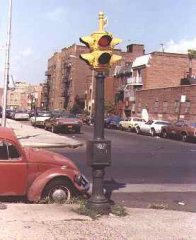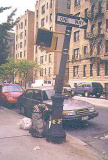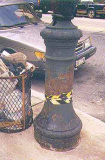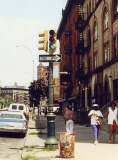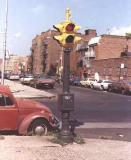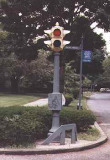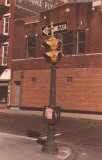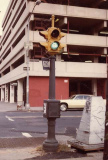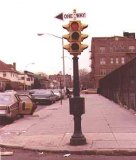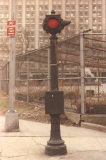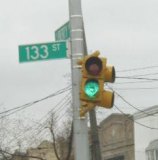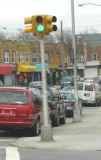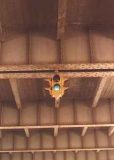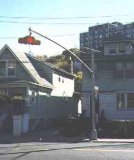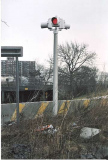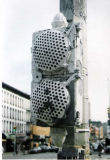The little olive-colored stoplight, with its serrated exterior and the fluted base, once was to NYC streets what the passenger pigeon was to the skies. They weren’t on every corner…traffic wasn’t so heavy as to mandate their universal presence…but as often as not, two of these, cater-cornered, was enough to control traffic and allow people to cross the street in peace. Of every two stoplights, one had a control box (like the one at right).
They were used throughout the city except, of course, on Fifth Avenue, which has always had its own species of specialized lampposts and stoplights. The ones on Fifth, as I recall, had a statue of the Roman god Mercury on their apices.
In the late 1950s, huge stoplight poles with guy-wired masts that looked like the more heavily-muscled older brothers of the aluminum octagonal poles began to appear. Over the next two decades they would largely push out the “Olives” until today, only a handful of original ones are left. On wider, more important streets, tall poles resembling Corvington lamps but with a spoked wheel decoration in the scrollwork, were installed beginning in 1924. All but a handful of those remain today –most were eliminated during the 1950s and 1960s.
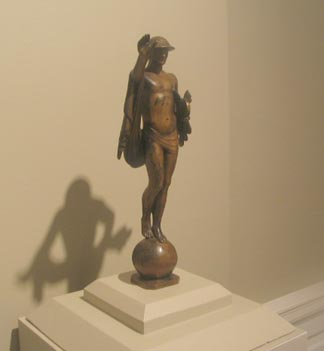 In the 1930s, special stoplights designed by architect of the Museum of the City of New York, Joseph Freedlander, were installed, each surmounted by a bronze figure of Mercury. This one is in the collection of the MCNY. Most Mercurys were removed in 1965 when new lamppost designs by Donald Deskey were installed.
In the 1930s, special stoplights designed by architect of the Museum of the City of New York, Joseph Freedlander, were installed, each surmounted by a bronze figure of Mercury. This one is in the collection of the MCNY. Most Mercurys were removed in 1965 when new lamppost designs by Donald Deskey were installed.
Photo: Matt Weber
Until a few years ago, the disintegrating remnants of one of the “Wheel” poles, having lost its wheel, stood creakily at Edgecombe Avenue and West 139th in Harlem, guarded by one of the guy-wired stops that took its place.
At left, the whole pole, captured by Matt Weber;next, the pole partially collapsed, its wheel missing, probably after a truck accident. shot by Bob Mulero; and next, the stump it was finally reduced to, holding up the pedestrian control signs. Few people in the area knew the lineage it represents. Other “Wheelies” in the area had been similarly reduced (right).
 An extant Wheelie at Park Avenue and 46th Street at the Helmsley Building
An extant Wheelie at Park Avenue and 46th Street at the Helmsley Building
These larger cast-iron stoplights first began to show up in the late 1920s as wide boulevards began to appear and traffic got heavier. They appeared on narrower roads as well.
I initially thought that the wheel design in the ironwork was a nod to the nautical nature of NYC’s oceanside location, but many Forgotten Fans have written and said they believe it represents an automotive steering wheel. There may be some truth in both.
These models were still somewhat common by the early 1960s, but by then, the guy-wired poles were supplanting them at a rapid rate.
Unlike their cast-iron lamppost cousins, the histories of the “Olives” aren’t easy to document. Because stoplights did not become a widespread traffic control device until the mid-Twenties, I’d say these poles first began to proliferate from the late 1920s through the mid-Thirties. While they do sport lively detail, there’s not as much ornamental metalwork as you see, say, in lampposts from the 1890s through 1920s.
Occasionally the Olives were modified to adapt to local traffic conditions. On busier corners, an amber light was added and on corners with less traffic but a need for some control, a ‘cyclops’ light that flashed a cautionary red or amber was mandated.
There were occasional variants on the red and green Olive configuration. At busier corners, an amber (yellow) light would be added to the light, and at corners that warranted some control, Cyclops lighst would be installed that blinked red or yellow.
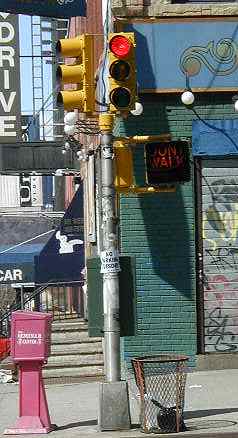
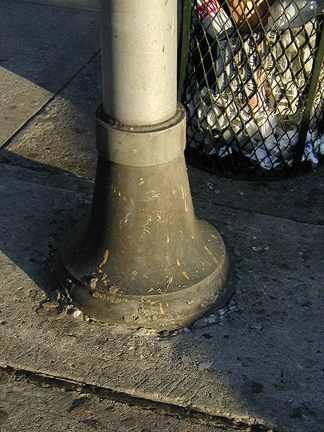
I’m not quite sure when, but in the late Fifties or early Sixties, it was determined to phase the Olives out and replace them with the simplified design and cylindrical shafted poles like the one on 10th Avenue at right. THese poles, which still do the job today, originally featured a sculpted base that became boxier after a few years.
I believe two-light stoplights were outlawed by a federal regulation some time back, but they stubbornly hung on in Ozone Park’s Liberty Avenue until about 2000, when they were replaced by traditional 3 light models.
Stoplights have had to improvise when dealing with overpasses, like on the now-demolished West Side Highway and under the subway overpass in Edgemere, Queens.
LEFT: The stoplight world changed when the huge guy wired posts, like this Cyclops on Castleton Avenue in Staten Island, started to show up in the late 50s.
At first, the lamps (not the poles) sported the same olive paint job that the stoplights they replaced did.
In 1965, though, all the lights were painted yellow, likely in an effort to increase their visibility. In the past couple of years, though, some of the stops have again begun to sport non-yellow paint schemes.
Also this row, two modern Cyclops lights and a two-bulb signal light on West 125th Street in Harlem.
Many of the pics on this page are from the camera of Forgotten Fan Bob Mulero.
Also see an earlier Forgotten page on stoplights here.


